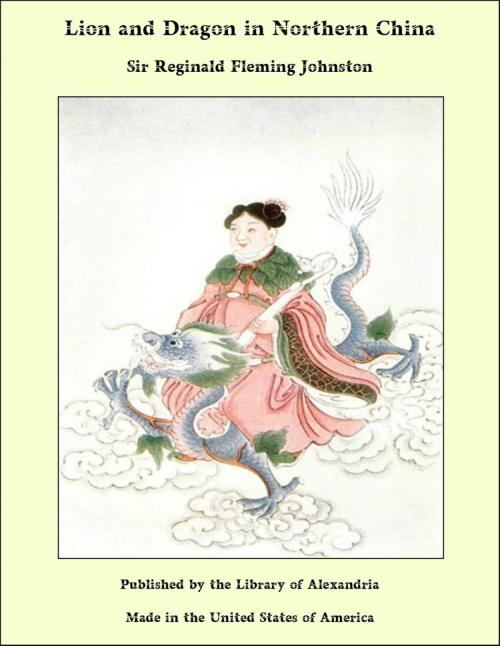Lion and Dragon in Northern China
Nonfiction, Religion & Spirituality, New Age, History, Fiction & Literature| Author: | Sir Reginald Fleming Johnston | ISBN: | 9781465585745 |
| Publisher: | Library of Alexandria | Publication: | March 8, 2015 |
| Imprint: | Language: | English |
| Author: | Sir Reginald Fleming Johnston |
| ISBN: | 9781465585745 |
| Publisher: | Library of Alexandria |
| Publication: | March 8, 2015 |
| Imprint: | |
| Language: | English |
Less than a dozen years have passed since the guns of British warships first saluted the flag of their country at the Chinese port of Weihaiwei, yet it is nearly a century since the white ensign was seen there for the first time. In the summer of 1816 His Britannic Majesty's frigate Alceste, accompanied by the sloop Lyra, bound for the still mysterious and unsurveyed coasts of Korea and the Luchu Islands, sailed eastwards from the mouth of the Pei-ho along the northern coast of the province of Shantung, and on the 27th August of that year cast anchor in the harbour of "Oie-hai-oie." Had the gallant officers of the Alceste and Lyra been inspired with knowledge of future political developments, they would doubtless have handed down to us an interesting account of the place and its inhabitants. All we learn from Captain Basil Hall's delightful chronicle of the voyage of the two ships consists of a few details—in the truest sense ephemeral—as to wind and weather, and a statement that the rocks of the mainland consist of "yellowish felspar, white quartz, and black mica." The rest is silence. From that time until the outbreak of the Sino-Japanese War in 1894 the British public heard little or nothing of Weihaiwei. After the fall of Port Arthur, during that war, it was China's only remaining naval base. The struggle that ensued in January 1895, when, with vastly superior force, the Japanese attacked it by land and sea, forms one of the few episodes of that war upon which the Chinese can look back without overwhelming shame. Victory, however, went to those who had the strongest battalions and the stoutest hearts. The three-weeks siege ended in the suicide of the brave Chinese Commander-in-Chief, Admiral Ting, and in the loss to China of her last coast-fortress and the whole of her fleet. Finally, as a result of the seizure of Port Arthur by Russia and a subsequent three-cornered agreement between Japan, China and England, Weihaiwei was leased to Great Britain under the terms of a Convention signed at Peking in July 1898. The British robe of empire is a very splendid and wonderfully variegated garment. It bears the gorgeous scarlets and purples of the Indies, it shimmers with the diamonds of Africa, it is lustrous with the whiteness of our Lady of Snows, it is scented with the spices of Ceylon, it is decked with the pearls and soft fleeces of Australia. But there is also—pinned to the edge of this magnificent robe—a little drab-coloured ribbon that is in constant danger of being dragged in the mud or trodden underfoot, and is frequently the object of disrespectful gibes. This is Weihaiwei.
Less than a dozen years have passed since the guns of British warships first saluted the flag of their country at the Chinese port of Weihaiwei, yet it is nearly a century since the white ensign was seen there for the first time. In the summer of 1816 His Britannic Majesty's frigate Alceste, accompanied by the sloop Lyra, bound for the still mysterious and unsurveyed coasts of Korea and the Luchu Islands, sailed eastwards from the mouth of the Pei-ho along the northern coast of the province of Shantung, and on the 27th August of that year cast anchor in the harbour of "Oie-hai-oie." Had the gallant officers of the Alceste and Lyra been inspired with knowledge of future political developments, they would doubtless have handed down to us an interesting account of the place and its inhabitants. All we learn from Captain Basil Hall's delightful chronicle of the voyage of the two ships consists of a few details—in the truest sense ephemeral—as to wind and weather, and a statement that the rocks of the mainland consist of "yellowish felspar, white quartz, and black mica." The rest is silence. From that time until the outbreak of the Sino-Japanese War in 1894 the British public heard little or nothing of Weihaiwei. After the fall of Port Arthur, during that war, it was China's only remaining naval base. The struggle that ensued in January 1895, when, with vastly superior force, the Japanese attacked it by land and sea, forms one of the few episodes of that war upon which the Chinese can look back without overwhelming shame. Victory, however, went to those who had the strongest battalions and the stoutest hearts. The three-weeks siege ended in the suicide of the brave Chinese Commander-in-Chief, Admiral Ting, and in the loss to China of her last coast-fortress and the whole of her fleet. Finally, as a result of the seizure of Port Arthur by Russia and a subsequent three-cornered agreement between Japan, China and England, Weihaiwei was leased to Great Britain under the terms of a Convention signed at Peking in July 1898. The British robe of empire is a very splendid and wonderfully variegated garment. It bears the gorgeous scarlets and purples of the Indies, it shimmers with the diamonds of Africa, it is lustrous with the whiteness of our Lady of Snows, it is scented with the spices of Ceylon, it is decked with the pearls and soft fleeces of Australia. But there is also—pinned to the edge of this magnificent robe—a little drab-coloured ribbon that is in constant danger of being dragged in the mud or trodden underfoot, and is frequently the object of disrespectful gibes. This is Weihaiwei.















